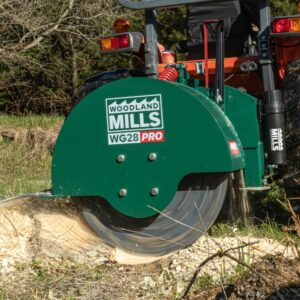Across suburban backyards and sprawling bushland properties alike, Australians are increasingly taking land management into their own hands. With sustainability, self-sufficiency, and bushfire preparedness high on the agenda, the humble stump grinder has emerged as an unexpected hero of property maintenance. From weekend gardeners in Brisbane’s suburbs to rural landowners in Victoria’s high country, more people are making the decision to buy a stump grinder as part of their home improvement or land-clearing toolkit in 2025.
This rise in demand isn't just about convenience—it's a reflection of a deeper cultural shift. Australians are more involved in hands-on property care than ever before, whether that means reclaiming garden space, clearing paddocks, or reducing fire risk. Stump grinders, once reserved for contractors and councils, are now becoming a common sight in private sheds and garages. Here’s a closer look at why Aussies are making the switch from hiring to owning, and what’s fuelling the surge in DIY stump removal across the country.
Bushfire Risk Is Driving Smarter Land Management
After years of devastating bushfire seasons, Australians are acutely aware of the risks posed by unmanaged vegetation. One of the lesser-discussed hazards in this equation is the tree stump. Left behind after felling or storm damage, stumps often dry out, rot, and become a combustible part of the undergrowth. In areas such as the Blue Mountains, southern Queensland, or the Adelaide Hills, this is more than an aesthetic issue—it’s a safety one.
For this reason, many homeowners and rural property managers are choosing to invest in their own equipment rather than waiting for council cleanup or hiring a contractor each time. To buy a stump grinder is to take proactive steps toward safer, more manageable land. The process of grinding out old stumps doesn’t just reduce fire fuel; it also eliminates potential termite habitats and helps control fungal growth that might threaten nearby vegetation.
The independence of owning a stump grinder also means landowners can address hazards quickly, without the delays or costs of outsourcing. As fire awareness continues to shape how we approach outdoor maintenance, stump grinders have moved from specialist tools to essential safety gear—particularly in semi-rural and bush-adjacent communities.
Homeowners Are Reclaiming Space and Boosting Property Value
One of the most tangible benefits of removing old tree stumps is the way it transforms a yard. Whether you're landscaping for aesthetics or preparing to build, stumps are often a physical and visual obstacle. In suburban neighbourhoods across Sydney and Melbourne, residents are realising that even a single stump can reduce usable garden space and drag down the appearance of their home.
Grinding out stumps opens up new possibilities: smoother lawns, flatter ground for outdoor entertaining areas, or space to install new fencing, garden beds, or retaining walls. For families adding play equipment, installing a pool, or planting a veggie patch, removing old stumps is often the first step in the transformation.
More homeowners are choosing to buy a stump grinder rather than rely on occasional hire services, especially when multiple stumps need removal or when ongoing yard projects are planned. Over time, owning the equipment becomes more cost-effective than repeated service fees. Just as lawnmowers became a suburban standard decades ago, stump grinders are now finding their place in sheds as Aussie families invest in reclaiming every inch of their backyard potential.
Small Businesses and Tradies Expand Their Service Offerings
The growth in stump grinder purchases isn’t limited to homeowners. Landscapers, arborists, handymen, and general maintenance tradies are increasingly adding stump grinding to their list of services. In a competitive market, having your own grinder means being able to say yes to more jobs—particularly in regional areas where clients value convenience and comprehensive service.
For small business owners, the decision to buy rather than hire often comes down to flexibility. A portable, tow-behind or walk-behind stump grinder allows tradies to respond to short-notice jobs, bundle stump removal with tree felling or garden clean-ups, and save on hire fees. Over time, this builds customer trust and boosts revenue.
Rural contractors servicing large-acreage clients or lifestyle properties find stump grinders especially useful for fencing prep, trail clearing, and firebreak maintenance. With property owners increasingly looking for single-provider solutions, having a stump grinder in the ute or trailer can be the competitive edge a business needs.
The Second-Hand Market and Entry-Level Models Are More Accessible
Historically, the high cost of stump grinders kept them firmly in the realm of professional operators. But in 2025, the market has expanded to include a wide range of models suited to different budgets and workloads. For weekend warriors and hobbyists, compact entry-level machines are now widely available at local hardware stores and online. This accessibility has helped drive uptake, especially among homeowners wanting to tackle their own landscaping.
Meanwhile, the growth of the second-hand equipment market means that those looking to buy a stump grinder can often find quality used machines at reasonable prices. Platforms such as Gumtree, Facebook Marketplace, and specialised equipment resellers offer refurbished units that are perfect for occasional users. In some cases, people who have finished a major project will sell their grinder, giving others the chance to own without the new-equipment price tag.
This has created a virtuous cycle. More units in circulation mean more knowledge-sharing, online tutorials, and confidence among buyers. What was once seen as specialist machinery is now considered within reach, and increasingly, within the skill set of everyday Australians with a bit of patience and a lot of yard to clear.
Environmental Sustainability Meets Practical Utility
While stump grinders are mechanical tools, they’re also helping promote a more sustainable approach to land and garden management. Grinding down a stump eliminates the need for chemical herbicides that can leach into the soil or nearby waterways. It also prevents the regrowth of invasive tree shoots that often sprout from an untreated base.
In environmentally conscious communities, especially near protected bushland or water catchments, mechanical stump removal is often preferred for its low impact. The resulting mulch from stump grinding can be repurposed in garden beds, reducing waste and improving soil health. This aligns well with the values of many Aussie households who want their outdoor work to reflect a respect for the land.
For landcare groups, community garden organisers, and even school groundskeepers, owning a stump grinder also means greater self-sufficiency in site maintenance. Instead of scheduling council support or hiring private services, they can handle smaller jobs internally—saving money while staying aligned with their ecological values.
Conclusion: Stump Grinders Are No Longer Niche—They’re Mainstream Utility
From leafy backyards in the suburbs to expansive rural properties, stump grinders are emerging as one of 2025’s most in-demand landscaping tools. The decision to buy a stump grinder is being driven by a mix of necessity, practicality, and empowerment. Australians want control over their outdoor spaces—and whether it’s for safety, sustainability, or aesthetics, stump removal has become a job worth doing right.
As fire awareness rises, outdoor living grows, and extreme weather events increase, the stump grinder is no longer just a specialist’s tool. It’s a sign of smart, proactive land care. In a country known for its connection to the land, it makes perfect sense that more Aussies are adding stump grinders to their toolkit—not just for the jobs they have now, but for the peace of mind they’ll carry into every season ahead.


































